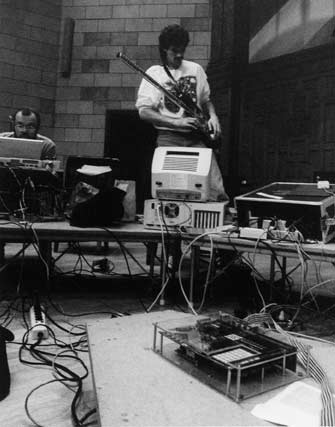3.1 Borrowing and Stealing
Borrowing and Stealing, designed by Phil Stone, was the second piece defined for the premiere New York performances which proposed a much more ambitious protocol for using the shared memory resource that the Hub provided. Its subject and title anticipated what would eventually become the battleground for networked musical technologies -- the plunderphonic reality that digital information as symbolic representation of sound is all too easily and perfectly replicated, that such information cannot really be owned, but to be kept alive must be continually transformed.
"Melodic riffs are composed by individual participants and sent to the Hub's shared memory, where they become fair game to be appropriated by the other participants. A "borrowed" (or "stolen", depending on one's perspective) riff may then be transformed in any of a multitude of ways, and replayed. The transformed riff is in turn sent to the Hub and made available to the other players. In this way, musical information flows instantly and reproducibly among the members of the ensemble without regard for copyright, attribution, or other proprietary notions."
-- Phil Stone, from "The Hub" Artifact 1001 CD program notes
Technically, this was accomplished by providing each player with a separate area in the Hub's memory to which the melody that he was playing had to be published. Essentially, it was a shared database marked off into territories over which each individual player owned write privileges, but where reading (and copying) was free. (Of course, this was only a protocol that each player was individually responsible for programming on their own computer, there was no "server" that enforced the concept of territorial rights!).
"Pitch and duration information, as well as a loop-start synchronization flag, will be sent to the Hub as the melody plays. Each composer may, at any time, copy information from another composer's melody data and use it for his or her own melody data."
-- PS, from piece specification
Musically speaking, this was a tight spec: it defined a texture made
entirely from repeating melodies, a kind of metamorphosing minimalism.
As in Simple Degradation, The Hub once again was used to deliver common
musical material to all the players; but in this piece not one but every
member of the group was contributing to it. This made the piece more evolved
in an interactive sense -- there was no one conductor controlling the
musical direction, but six equal players borrowing and stealing equally
from each other but still intertwined and interdependent. Phil had coded
a graphical input system for melody generation on his Amiga computer,
in which he drew melodic contours with a mouse that would be instantly
rendered as melodies published to the Hub. In practice, most of the rest
of the group simply grabbed his melody and started transforming it, so
that the music rarely had more than one melodic source for the whole texture
that evolved. This could have led to a very formal, tightly controlled
music made entirely out of subtle variations, or reflections, on the same
material. But instead there was a more anarchic response as our musical
proclivities favored radical transformations, such as changing the tuning
of the melody, stretching its shape by exploding interval sizes or rhythmic
relations beyond recognizable connection to the original, applying frequency
and rhythmic proportions of the melody to timbral control parameters of
un-pitched sounds, etc. The piece specification did not prevent individual
members from creating realizations that became an algorithmic free-for-all
spinning off from its central core. Realizing a good performance of the
piece became a balancing act between revealing the organizational process
at its core without making it too dominating of the music. Phil liked
to emphasize the former by directing additionally that the melodies become
shorter and shorter towards the end of the piece. Our renditions of this
piece probably reflected a creative internal tension in the band behind
its minimalist and improvisational tendencies.
audio of Borrowing and Stealing

Phil Stone with his "Axe-Thing" controller, standing, with the SYM-Hub in the foreground. Tim Perkis is on the left. From a concert at Mills College in 1989.
Photo: Jim Block Photography.